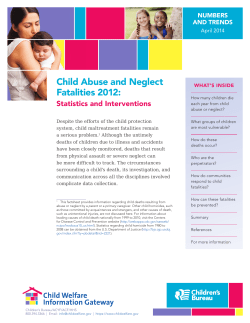
Texas Department of Family and Protective Services (DFPS
Senate Health and Human Services Committee Interim Charge Presentation Judge John Specia, DFPS Commissioner February 20, 2014 Interim Charge • Review the Department of Family and Protective Services’ efforts to reduce child fatalities. • Review the process by which the Department of Family and Protective Services collects and uses data to evaluate agency performance and improve outcomes for children in the Child Protective Services system. • Make recommendations to ensure the process effectively uses data to strategically improve caseworker performance, and identify and improve upon deficiencies within the system and improve overall outcomes for children and reduce child fatalities. 2 Presentation Overview • Child Fatalities o o o o FY 2013 data Child fatality audit Plan to address child safety Prevention efforts • Data Use o Current data resources and tools o Current uses of data o Plans to improve use of data 3 Part One Child Fatalities 4 Child Protective Services – FY 2013 In Fiscal Year 2013 • 7,159,172 children lived in Texas • 160,240 abuse/neglect investigations were completed by CPS • 27,924 children were in the state’s conservatorship on August 31, 2013 o 16,676 in foster care o 10,059 in kinship care o 1,189 in other settings 5 Confirmed Abuse/Neglect Fatalities in the General Population in FY 2013 1100 500 1000 900 994 1,016 1,024 973 Reported Child Fatalities 400 882 Abuse/Neglect Fatalities 804 280 800 700 223 213 300 227 231 212 200 600 156 500 Abuse/Neglect Fatalities Reported Child Fatalities 1,024 100 2007 2008 2009 2010 2011 2012 2013 6 Child Fatalities in the General Population in FY 2013 In FY 2013, CPS completed 160,240 investigations of abuse or neglect 804 Reported Child Fatalities Statewide (Includes CCL, CPS, RCCL) 648 156 Fatalities unsubstantiated as child abuse or neglect Confirmed child abuse or neglect related fatalities 84 72 No prior CPS history Prior CPS history 49 23 No CPS case at time of death Open CPS case at time of death 7 Child Fatalities in the General Population Child Fatalities in Texas FY 2013 Total - 156 Abuse fatalities include: ▪ Blunt Force Trauma Abuse ▪ Stabbing 41% (64) ▪ Suffocation Neglect 59% (92) Neglect fatalities include: ▪ Drowning ▪ Unsafe Sleep ▪ Medical Neglect 8 General Population – Safety Factors • In child fatality cases, factors that presented safety threats to the child included: o o o o o o Lack of protective capacity of the caregiver Repeat maltreatment to the child Access to a swimming pool Access to a firearm Inappropriate sleeping arrangements Children age three and under represent 80% of all child fatalities from abuse or neglect 9 Child Fatalities in Conservatorship in FY 2013 50000 20 Children in Conservatorship 44,928 44,780 45000 45,694 45,159 42,890 40,840 15 40000 10 Children in Conservatorship 35000 10 Abuse/Neglect Fatalities in Conservatorship 30000 5 4 3 25000 5 1 0 2 20000 Abuse Neglect Fatalities in Conservatorship 47,104 0 2007 2008 2009 2010 2011 2012 2013 10 Child Fatalities in Conservatorship • In FY 2013, 10 children in DFPS conservatorship died as the result of abuse or neglect by the child’s caregiver o DFPS Conservatorship includes both foster care and kinship homes o 7 child fatalities occurred in foster care o 3 child fatalities occurred in kinship care 11 Child Fatalities in Conservatorship – Foster Care • In FY 2013, there were 7 abuse or neglect related fatalities in foster care placements: o Physical abuse by caregiver – 1 child o Unsafe sleep – 2 children o Drowning – 2 children o Suicide – 1 child o Neglect/seizure-related – 1 child 12 Child Fatalities in Conservatorship – Kinship Care • In FY 2013, there were 3 abuse or neglect related fatalities in unverified kinship care placements: o Drowning – 1 child o Gun-related accident – 1 child o Neglectful supervision – 1 child (kinship caregiver left the child in the care of the biological parents who then abused the child) 13 Audit of Child Fatality Review Process • In FY 2013, DFPS Internal Audit was directed to conduct an audit of the existing child fatality review processes • The audit found that DFPS needed to make efforts to identify lessons learned and ensure the agency has a clear and consistent response to each fatality • In particular, it was noted that policy and procedures are maintained in multiple documents and not consistently presented in a logical flow, which requires staff to piece together information from various places to perform their job functions 14 Child Safety Plan • DFPS developed a child safety action plan that includes implementation of the recommendations in the audit and changes proposed in response to specific child fatality cases, identified trends, or as a recommendation from a child safety forum with providers. • Areas addressed in the child safety plan include: o o o o o Child fatality review process Kinship Care Foster Care DFPS training and casework practices Regulation of contracted providers 15 Child Safety Plan – Reviews of Child Fatalities • In response to the audit findings and recommendations, DFPS overhauled the child fatality process to be more consistent, transparent, and comprehensive: o Restructured the child fatality review process and clarified the role of external reviewers to ensure thorough review of fatality investigations o Streamlined and clarified internal fatality review policy and protocols to ensure consistent application across all regions. Consolidated all fatality related procedures into a separate manual o Implemented centralized, comprehensive data collection that allows for real time analysis of fatalities o Established an ongoing process to analyze issues and trends identified during child fatality reviews in an effort to prevent child fatalities. 16 Child Safety Plan – Kinship Care • In FY 2013 there were 3 fatalities in kinship care, though there were none in FY 2012. Each of the 3 fatalities was related to improper supervision. To address concerns, DFPS: o Updated the manual provided to all kinship caregivers to include more information on ensuring child safety. o Reviewed kinship policies, procedures, and rules to ensure that they are up-to-date and that safety is emphasized. o Strengthen ongoing assessment of child safety risks during home visits. o Is conducting an additional safety check on all children aged 3 and under who are in kinship placements. o Is updating the DFPS home assessment for kinship placements to ensure that caseworkers clearly identify risks during the family’s home study and take appropriate steps to address those identified risks. 17 Child Safety Plan – Foster Care o With 90% of children in foster care placed with private providers, how DFPS regulates and monitors those providers is critical. DFPS is taking the following actions: o In Region 7, conducted unannounced visits in foster/adopt homes with very young children and conducted a review of frequent visitors to ensure appropriate background checks had been completed (November 2013) o Conducted child safety forums with providers across the state (completed December 2013) o Strengthening minimum standards related to the screening of foster parents (See slides 20-21) o Conducting a contract monitoring audit to assess the process for evaluating residential provider performance, with a focus on child safety and quality of care 18 Child Safety Plan – Strengthening DFPS Training • In 46% of child fatalities, CPS had prior involvement with the family. In order to ensure CPS workers have the training to identify safety risks, DFPS is taking the following steps: o Conducted a statewide training on safety for all CPS foster/adopt staff (November 2013) o DFPS is also updating training for caseworkers on identifying and addressing safety concerns. Training will focus on better communication between CPA and CPS staff. (Spring 2014) o Increase training for Human Services Technicians (HST), who often transport children to services, to enhance their abilities to recognize safety issues. Because HSTs are an additional set of eyes on children, they serve as another opportunity to observe and ensure that child’s safety. (Spring 2014) 19 Child Safety Plan – Strengthening Minimum Standards • At the April 2014 DFPS Council meeting, DFPS is proposing changes focused on enhancing safety in foster care: o Require child placing agencies (CPAs) to implement a plan to evaluate the accuracy of foster home screenings and the quality of supervisory visits. o Require a more comprehensive foster home screening process by CPAs to include: additional law enforcement checks assessment of support systems required interviews with adult children additional reference interviews additional information on finances 20 Child Safety Plan – Strengthening Minimum Standards • Proposed Changes, Continued o Require child placing agencies (CPAs) to make more unannounced visits to the foster home (2 per year). During the visits, the CPA will be required to look at: o Stressors in the home o Appropriateness of supplementary caregivers for the children o Changes to the household o Changes to household makeup o Require CPAs to improve processes for identifying safety risk factors prior to children being placed in the home. o Once the homes are verified, CPAs will be required to conduct more thorough visits and continually identify and address risk factors in the home. 21 Abuse/Neglect Prevention Efforts • Public awareness campaigns to educate about safety o Help and Hope – connecting families with community resources o Room to Breathe – promoting safe sleep for infants o Watch Kids Around Water - drowning prevention o Look Before You Lock - preventing deaths in hot cars • DFPS safety webpage o Section of DFPS website dedicated solely to safety information o ChildSafety@dfps.state.tx.us – email box for safety questions or concerns 22 Targeted Prevention Efforts • Project HIP o Targets certain high risk families who have had a recent new birth • Project HOPES o Community-based programs focusing on high risk families with children age 0-5 • STAR o Community providers in every Texas county who provide family crisis counseling and emergency respite care 23 Part Two Data Use 24 Primary Data Source Systems • IMPACT o Comprehensive abuse/neglect case management system o Addresses the full range of protective services, including intake, investigations, family-based safety services, foster care, and adoption o The infrastructure is 17 years old and resources required for system maintenance are expensive and increasingly hard to find o Usability has decreased over time, particularly compared to current web applications • Data Warehouse o o o o o o Subset of the information in IMPACT Official data source for non-financial agency reporting and data analysis Integrates data from multiple systems Makes data more manageable, accessible, and timely Enables management and workers to make more informed decisions Creates tangible reports that can be used as management tools 25 Using Data Strategically – Foster Care Redesign • Foster Care Redesign is an outcome-based model in which: o Data reported by Single Source Continuum Contractors and DFPS data are used to evaluate contractor performance o DFPS is collaborating with leading research organizations to: Establish baselines (using legacy system data) and targets associated with selected measures (e.g., permanency, placement stability) to assess contractor performance Implement a continuous quality improvement process that will provide opportunities for the contractor to make ongoing adjustments to meet established performance outcomes 26 Using Data Strategically – CPS Performance Dashboard • CPS has reviewed all available data to establish key measures related to safety, permanency and well-being • Data will be combined with case reads to examine the quality of casework at critical points to understand how system is working and where to target resources to most effectively improve outcomes • Supports a reasoned, planned approach to make necessary policy and process improvements • Provides a method for tracking whether improvements are resulting in better outcomes • Full implementation anticipated by May 2014 27 Plan to Improve Data Collection and Access • IMPACT Modernization o 83rd Legislature provided initial funding for IMPACT modernization o Project includes implementation of Business Intelligence tool o Will streamline caseworker documentation and improve usability of data, access, and data-driven decision making o The following initial improvements will be available by the end of 2014: Business Intelligence to improve the usability of the system for caseworkers, prompting them to take case actions Online data book with data that can be accessed and manipulated by the public External access to Court Appointed Special Advocates (CASA) 28 Long-term Vision for Data Use • Using Predictive Analysis to Support Decision Making o The modernization of the IMPACT case management system lays the foundation for predictive analytics – modeling and data-mining that analyze current and historical facts to make predictions about future, or otherwise unknown, events o DFPS is exploring opportunities in critical business areas to use Predictive Analytics to make better decisions, more quickly, and with less expense 29
© Copyright 2025










